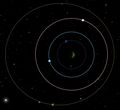Jool/ko
줄 은 가스행성이며, 커볼 행성계의 여섯번째 행성이다. 커발 스페이스 프로그램에서의 줄은 지구의 목성과 비슷한 행성이다. 줄은 커볼을 제외하고는 가장 큰 지름과 질량의 천체이다. 커빈 으로부터 줄까지 도달하는 것이 어려울 수도 있지만, 쥴이 가장 매력적인 타겟중 하나인 이유는 다섯 위성으로 구성된 거대하고 복잡한 줄계에 있다: 레이스, 볼, 타일로, 밥, 폴.
Contents
대기
|
Although Jool has a radius ten times greater than Kerbin, its atmosphere begins just twice as high (138.2 km). It is extremely dense, well suited for aerobraking from a high-speed interplanetary intercept. Orbiting just outside the atmosphere will give you a period of 94.7437 minutes, and a speed of 6,785 m/s. You typically do not need to go lower than 100 km to aerobrake. In general, the atmospheric pressure on Jool at an altitude expressed in meters is: Closer to the surface, the physics of the game start to break down. Due to its extremely thick atmosphere, terminal velocity is so low that lighter spacecraft will not even need parachutes or retrorockets. It is not impossible to land on its solid surface, though spacecraft are inevitably and invariably devoured by the Kraken. If the craft is very small, it may survive the Kraken, but the parts will explode once they are 100m below the surface. The message "... collided with Cloud" will display in the mission summary. If a Kerbonaut is put on EVA he will not be destroyed, making one-way sacrificial landings possible. However, as seen near the end of this video, the Kerbonaut will start to glitch out and shake uncontrollably. This only happens if you're on time warp 4. The game will later glitch and cut to a black screen with the altimeter going through numbers rapidly. Unless you restart the game, Kerbin's atmosphere will be missing. |
시간배속 기준표
| 시간 배속 | 최저 고도 |
|---|---|
| 1× | 어디서든지 |
| 5× | 200 000 미터 (대기 바깥에서) |
| 10× | 200 000 미터 (대기 바깥에서) |
| 50× | 200 000 미터 (대기 바깥에서) |
| 100× | 200 000 미터 (대기 바깥에서) |
| 1 000× | 300 000 미터 |
| 10 000× | 600 000 미터 |
| 100 000× | 1 200 000 미터 |
자연적으로 형성된 위성들
 The ocean moon 레이스, about to transit Jool. 줄은 다섯 개의 위성이 있고, 줄의 궤도면과 잘 정렬된 궤도에 각각 존재합니다:
Laythe, Vall, and Tylo are in a Laplace resonance, with orbital periods of 1:2:4 respectively. Despite the fact that the moons can easily eclipse both each other and Jool, they do not. Synchronous Orbits around any of the Joolian moons are impossible, as they all lie outside the Sphere of Influence of the moons, as is common with tidally locked bodies. |
갤러리
- Screenshot540.png
줄의 낮은 궤도를 도는 위성.
- Screenshot73.png
A Probe with winglets to steer. Note that as you descend deeper into the atmosphere, it gets harder to move at all, rendering RCS and winglets useless.
- Screenshote4141412.png
A view of Laythe, Vall, and Tylo during an aerobraking on Jool.
사소한 내용
- 줄은 지구나 금성과 거의 같은 적도 반경을 가지고 있습니다.
- 줄의 일몰과 일출은 황갈색의 그늘입니다.
- 줄과 마찬가지로, 목성의 가장 가까운 세 개의 위성(이오, 유로파, 가니메데)들은 1:2:4의 라플라스 공명이 있
습니다.
- 줄, 레이스 및 타일로 모두 7.85 m /s(≃ 0.8 g)의 표면 중력이 있습니다.
변경사항
- 폴이라는 위성이 추가되었습니다.
- 최초 릴리즈







